Pulling into Kashgar, our driver had to ask directions several times to find the hotel listed on our itinerary. After the Khotan experience, our expectations were low – so when we pulled up in front of a four-star, luxury hotel, the Barony, we were amazed and disbelieving.
| It wasn’t until we had gone into our rooms, bounced on the beds, found terrycloth robes and – wonder of civilized wonders – hair dryers in the bathrooms that we realized that we hadn’t made a mistake! The cleanliness and sparkle of the place was a welcome change. |  |
I immediately organized a laundry pile. When I tossed a fleece jacket over to Tom to put in the bag, a cloud of desert dust hung in the air between us!
This larger city had a different feel from Khotan, at once more Chinese – the main roads were lined with tall hotels and office buildings, all obviously very new – and more international, reflecting its centuries-old status as the end of the silk road and a major trading center. In a ten-yard space of a city block we could see snazzily-dressed Chinese ladies in short boots and bright jackets alongside shrouded Central Asian women and suit-clad Pakistani and Kazakh men.
We were greeted by our tour guide, Miss Wu, at the hotel, and the next morning, fueled by a reasonably American-style breakfast in the hotel lobby (though the only milk on offer was, to Miranda’s dismay, hot) we headed out to explore the city. Tom was excited – he had brought along some photos of his 1987 visit, and Miss Wu looked through them with him, noting where certain monuments and skylines had been torn down, built up or overwhelmed by new developments.
Any tourist’s first stop in Kashgar is its centerpiece, the Id Kah mosque overlooking the enormous Id Kah square, where the girls struck a pose:
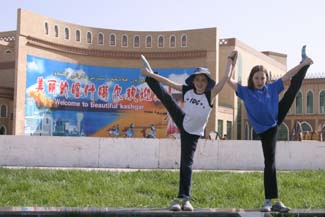 |
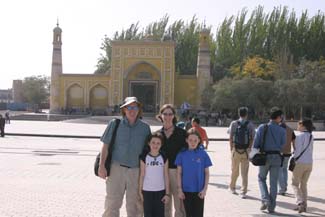 |
The mosque, the largest in China when you include all of its courtyards, has been built, rebuilt, renovated and expanded continuously for over 500 years. The interior is very peaceful, filled with trees and fountains. We weren’t allowed to take photos, and the hour of prayer had passed, so we only saw a few dozen men sitting on their prayer rugs, meditating or quietly conversing.
Taking advantage of this “social studies moment,” we talked to the girls about Islam, one of the three “religions of the book.” Since their own heritage is half-Christian (from me, the lapsed Catholic) and Tom (the cultural Jew), they were very interested in the similarities & differences between the three religions. Not to mention the fantastic, almost unbelievable tale that is the life of Mohammed.
| They learned that Muslims are obligated to give to charity – which explained why there were so many beggars surrounding the mosque – to follow the laws of the Koran, and to try to make a pilgrimage, or haj, to Mecca to circle the Kaabba at least once in their lives. | 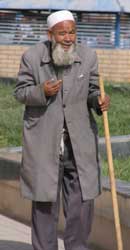 |
| On leaving the mosque, we walked down a lane heading into the old city, passing a row of small stores – literal holes in the wall surrounding the mosque – stuffed with all kinds of junk, crafts, and religious artifacts. Several stalls sold leftover memorabilia from early Communist days. | 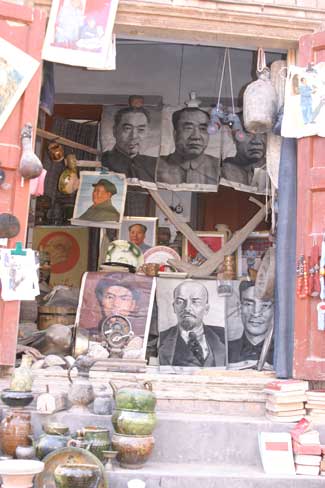 |
Tom later went back and bought some 20th century Chinese currency:
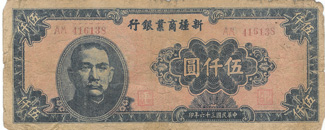 |
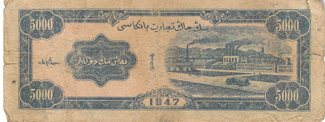 |
[ Note from Tom: I'm fascinated by old Chinese
currency, especially that printed between establishment of the Republic
of China in 1911, and the creation of the People's Republic of China in
1949). During this chaotic time therw were all kinds of currencies, printed
by many different banks. Inflation was rampant. I had never before seen
currency from that time period from China's northwest. As you can see,
the front is in Chinese, and the back is in Arabic. Needless to say I
bought almost everything I found in the market, since it's all quite rare.]
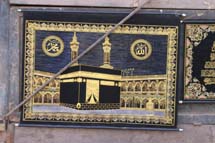 |
Armed with their new knowledge, the girls started pointing out all the symbols of Islam they saw: “Look! There’s the Kaaba on a carpet!" "And the crescent moon!” | 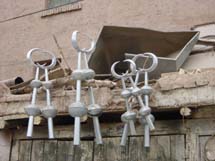 |
They also started to notice the completely-veiled women, whom we saw with increasing frequency:
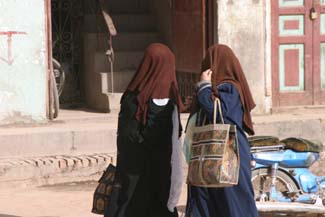 |
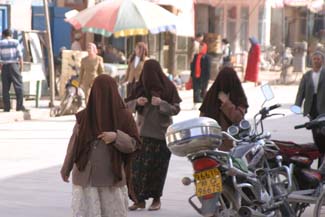 |
And then, we passed into the heart of Kashgar’s
old, mud-walled city.